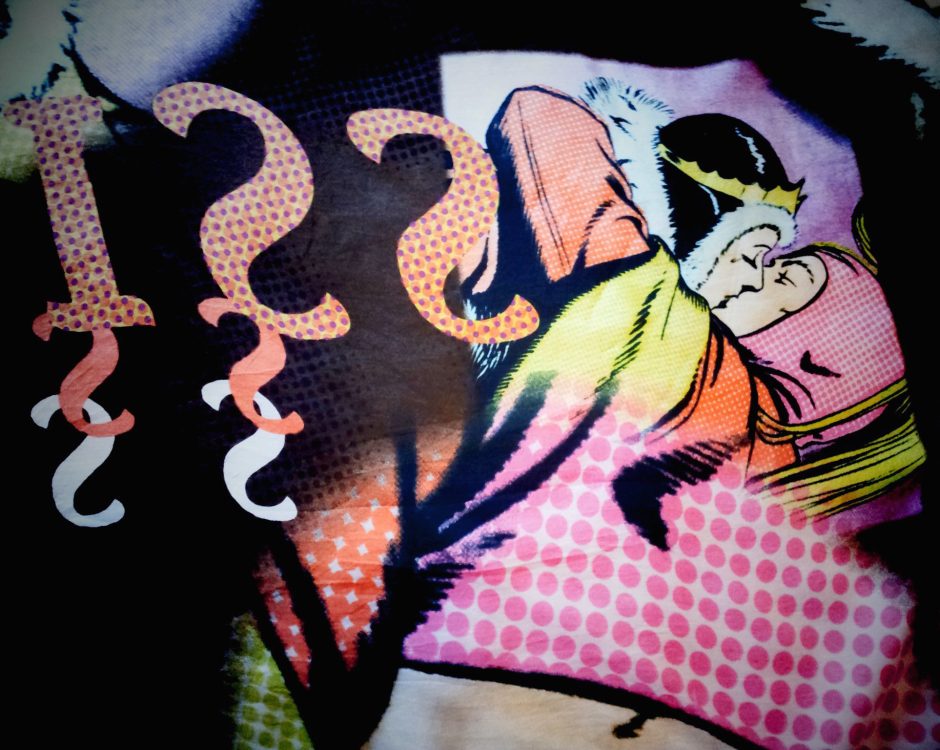Romance and the Deaf Girl
by Jessica White
The bus trip from our family property to primary school in town took forty minutes, and with my siblings and cousins aboard, it was a noisy journey. I sat on the left hand side of the bus, so that if someone spoke to me I’d be able to hear them with the ear that still had some hearing. Usually, I found it too hard to join in so I read my book, or looked at the passing grey-green gum trees, low granite outcrops dotted with prickly pear and stands of pine trees, or paddocks crammed with rust-coloured sorghum. As I grew older and became interested in romance, I saw myself walking hand-in-hand with a boy through the long, pale wiregrass, or lying next to him on a sun-warmed slab of granite encrusted with lichen.
Some twenty years later, I sat in the British Library in London, where I was researching nineteenth century expatriate writers. I discovered the novels of nineteenth century Queensland novelist Rosa Praed with the same blend of romance and the bush that had intoxicated me as a girl. In Policy and Passion, the second of Praed’s forty novels, her protagonist Honoria is seen by Englishman Barrington for the first time,
sitting upon the horizontal branch of a ti-tree, her back resting against the trunk, her feet almost touching the water, as it glided over a bed of stones, its melodious murmuring deafening the sound of voice or footfall, into a deep pool hemmed in by ferny banks. A book lay upon her lap, a cluster of the crimson bottle-brush flowers of the ti-tree swayed above her head, a sunbeam striking upon the coils of her hair made them look like ropes of reddish-gold.[1]
I was captivated by the scene’s sounds, colours and light, and the image of a red-haired girl reading in a tree. She could have been me.
The rest of Praed’s oeuvre was a romp, galloping through the bush (The Romance of a Station, 1889), or into other times such as ancient Rome (Nyria, 1904). Her heroines fought against beastly husbands and the strictures of marriage (The Bond of Wedlock, 1887). Some of them thrummed with the power of the occult, often a metaphor for illicit desire for other men or, subliminally, for women (The Soul of Countess Adrian, 1891). Praed’s works set in Australia were warped by a desire to belong that was unsettled by her family’s involvement in the brutal dispossession of Indigenous people (Fugitive Anne, 1902). Some of her novels also featured children with disabilities (Zero, 1884).
Praed’s daughter Maud was found to be deaf when she was two, just before the family emigrated from Queensland to London in 1876. At age six, Maud was enrolled in a school which taught her to speak rather than sign. Her mother, given the frequent references to class and breeding in her novels, would have been swayed by prevailing attitudes to deafness which (influenced by social Darwinism) maintained that deaf people should learn to interact with and marry hearing people so as to reduce the risk of congenital deafness. This was brought about through deaf people learning to speak, rather than hearing people learning to sign. As her speech was not always clear, Maud sometimes found herself in distressing social situations such as at a ball organised by friends of her family. She asked her brother Bulkley, ‘Why does not everybody dance with me? Why do they look at me like that when they are introduced?’[2]
The more I learned about Maud, in the decade or so that I spent with her and her mother, the more I realised that, while people have become more accepting of people with disabilities and less inclined to think of them as animals (an association which stretches back to ancient Rome), in many cases Maud’s and my experiences have been the same. We have been shoe-horned into a dominant, audist culture and made to feel inadequate for failing to fit in properly. We often stood on the edges of conversations, trying to listen and join in.
 As a thirteen year-old deaf girl, I felt that my inability to interact well enough to find a boyfriend, or to be attractive enough to catch someone’s eye, made me a failure. Part of this stemmed from growing up in a conservative rural community in which most of the adults I knew were married, and in which divorce and homosexuality were uncommon. Observing the people around me, it seemed that to be acceptable, a woman needed to get married and have children. Part of it also came from the numerous books I read.
As a thirteen year-old deaf girl, I felt that my inability to interact well enough to find a boyfriend, or to be attractive enough to catch someone’s eye, made me a failure. Part of this stemmed from growing up in a conservative rural community in which most of the adults I knew were married, and in which divorce and homosexuality were uncommon. Observing the people around me, it seemed that to be acceptable, a woman needed to get married and have children. Part of it also came from the numerous books I read.
In Narrative Prosthesis: Disability and the Dependencies of Discourse, Mitchell and Snyder observe that ‘disability pervades literary narrative, first, as a stock feature of characterisation and, second, as an opportunistic metaphorical device.’[3] They term this dependency upon disability ‘narrative prosthesis.’ Characters with disability abound in literature, but they usually operate to compensate for a limitation, or to rein in an excess.[4] Or, as Rosemarie Garland Thompson puts it in Extraordinary Bodies, ‘Corporeal departures from dominant expectations never go uninterrupted or unpunished, and conformities are almost always rewarded.’[5]
The only book I can recall reading as a girl which featured a character with a disability was Colin Thiele’s Jodie’s Journey.[6] Jodie, in constant pain from juvenile arthritis, escapes the fires of Ash Wednesday in her wheelchair on her parents’ farm. Jodie is too young for romance; she’s still in love with horses. She is punished for her disability through injury from the fire and damage to her horse. As I grew older, my reading shifted to the Sweet Valley High series, with its perfect Wakefield sisters in sweaters (no excess there). I then leapt into my mother’s shelves, where I gulped Colleen McCullough’s books and, when I was supposed to be studying for my final year exams, Jane Eyre. When a friend told me, ‘Rochester had to be blinded so that he would be Jane’s equal,’ I was shocked. Being blind didn’t mean lowering oneself and, besides, I thought Jane his superior in her fortitude and emotional intelligence.
Nothing in my reading of these romances suggested that I would be loved for being deaf alone; I was convinced that I needed to act as though I could hear to be acceptable. Sadly, not a great deal has changed in our romantic literature. While, as Emily Baldys notes, in recent years the genre has seen an increased prevalence of characters with disabilities, the meanings with which these characters are invested are still limited. In her analysis of characters with cognitive disabilities in five romance novels, Baldys indicates that ‘while purporting visibility and inclusion, [they] function primarily to bring both compulsory heterosexuality and compulsory able-bodiedness to bear on disabled sexuality.’[7] McCullough’s Tim (1974), for example (not one I encountered on my mother’s shelves) emphasises the protagonist’s wholeness of body before his disability is revealed, reducing him to a body rather than an individual with a subjectivity.
And yet, for all its contradictions and its many and varied critics, who complain that the genre, this ‘most female of forms,’[8] is anti-feminist, poorly-written and executed and reinforces stereotypes of femininity,[9] at the heart of romance is an unconditional acceptance of the other. For a girl on the cusp of adolescence, this seemed an answer to my persistent loneliness. It hooked into me and, never wavering, carried me through years of internet dating, dance classes, book clubs and friends of friends, even as each encounter left me feeling more and more alien. Eventually, through sheer luck, I picked up my partner in the most unromantic of circumstances, taking him home after a night of champagne and dancing in Brisbane’s Fortitude Valley. Continuing in this vein, he calls himself a post-romantic, refuses to buy me flowers and doesn’t believe in marriage. Yet in his efforts to speak clearly and to repeat to me the things I miss, he exhibits the same ethics of care around which romance revolves.
Maud wrote in a letter, ‘I am sorry to say I cannot agree with Mother’s exciting novels.’[10] Perhaps this was because she could see no place for herself within them. Yet I am certain that romance will evolve, that readers will become more sophisticated in their readings and expectations. This is already happening in scholarly work such as The Madwoman and the Blindman: Jane Eyre, Discourse, Disability, which presents nuanced re-readings of the presentation of disability in Jane Eyre.[11] Meanwhile young adult novels such as Talk Under Water,[12] Whisper,[13] or Invisible[14] represent young, deaf female protagonists who learn to accept their deafness, and from this point of confidence they contemplate relationships with other characters.
One day Barrington will come across Honoria, who cannot hear not because of the rush of a river, but because deafness is who she is, and she will be loved just the same.
[1] Rosa Praed, Policy and Passion: a Novel of Australian Life. Bentley, 1881, p. 121.
[2] Praed, Bulkley to Rosa Praed. Letter, undated, 8/8/11, Praed Papers, John Oxley Library.
[3] David T. Mitchell and Sharon L. Snyder, Narrative Prosthesis. U of Michigan P, 2014, p. 47.
[4] Ibid., p. 54.
[5] Rosemarie Garland Thomson, Extraordinary Bodies Figuring Physical Disability in American Culture and Literature. Columbia UP, 1997, p. 5.
[6] Colin Thiele, Jodie’s Journey, Walter McVitty Books, 1990.
[7] Baldys, Emily M. “Disabled Sexuality, Incorporated: The Compulsions of Popular Romance.” Journal of Literary & Cultural Disability Studies, vol. 6, no. 2, 2012, pp. 125–141, p. 128
[8] Pamela Regis, A Natural History of the Romance Novel. U of Pennsylvania P, 2003, p. 53.
[9] Such charges are robustly refuted by Pamela Regis in A Natural History of the Romance Novel.
[10] Maud Praed to Dr Moore. Letter, 27th September 1905, 3473/3/6 Case Book, Surrey History Centre.
[11] David Bolt, Julia Miele Rodas, and Elizabeth J. Donaldson. The Madwoman and the Blindman : Jane Eyre, Discourse, Disability. Ohio State UP, 2012.
[12] Kathryn, Lomer, Talk under Water. UQP, 2015.
[13] Chrissie Keighery, Whisper. Hardie Grant Egmont 2015.
[14] Cecily Anne Paterson, Invisible. Primedia eLaunch, 2015.

